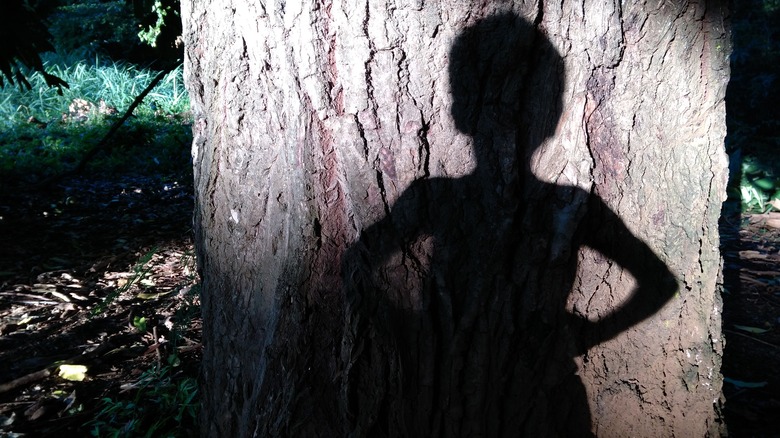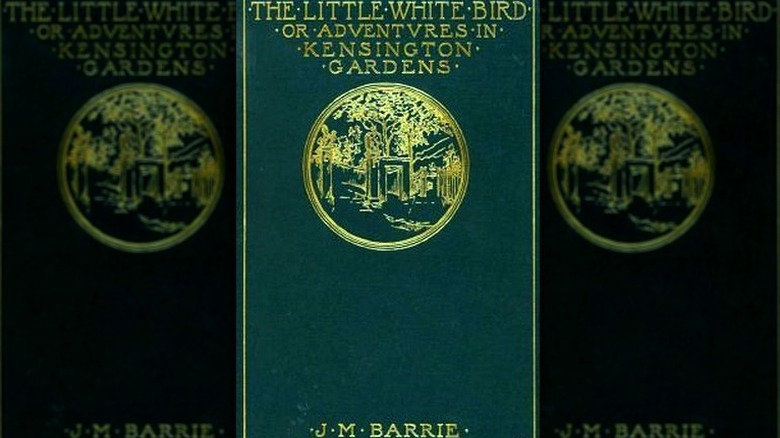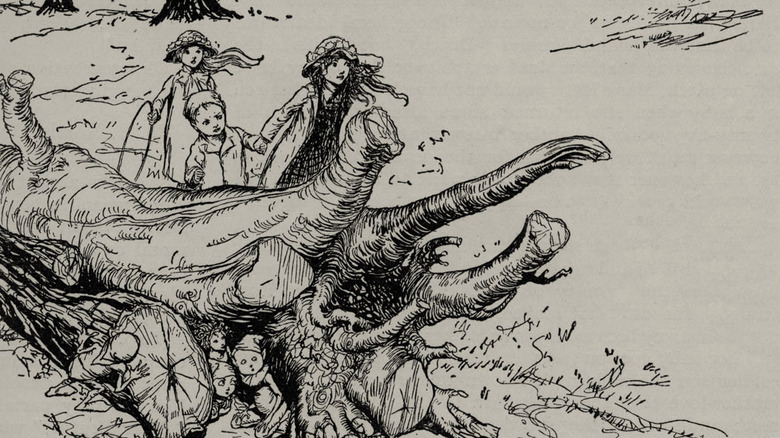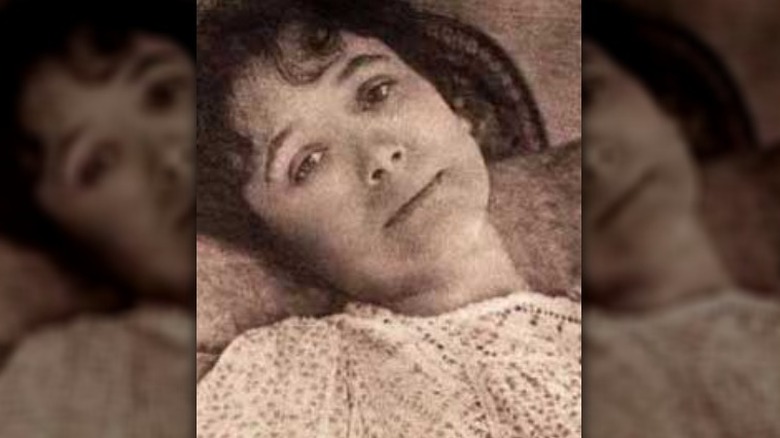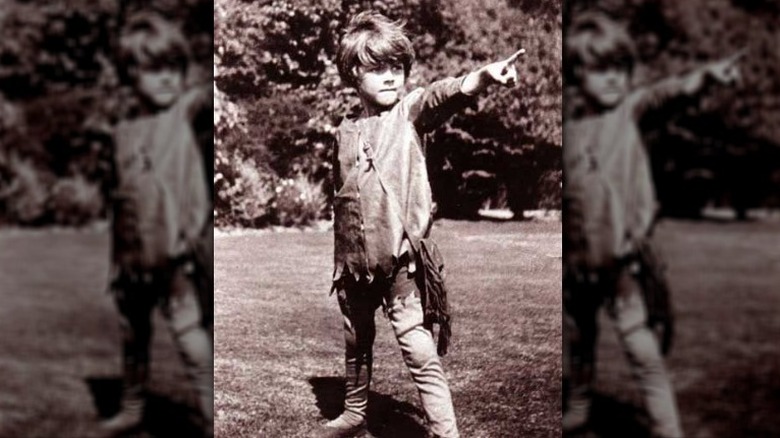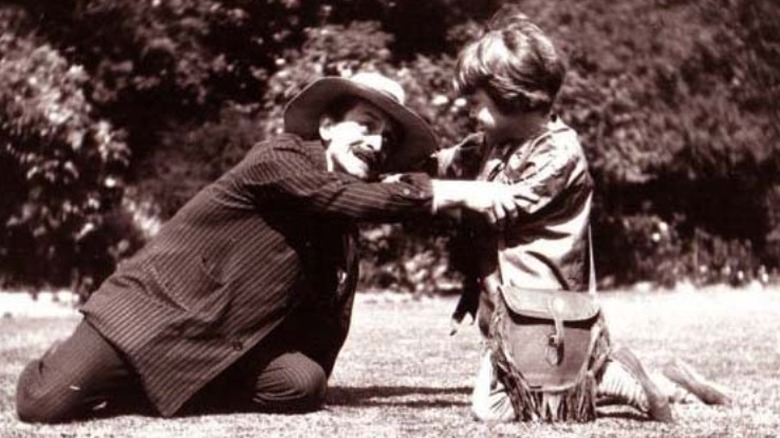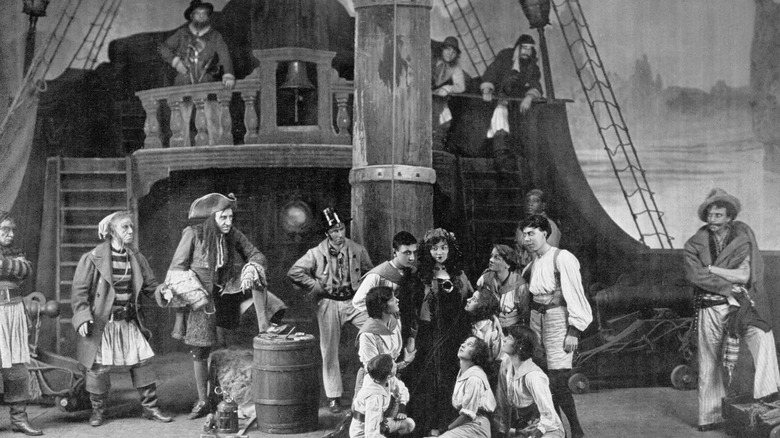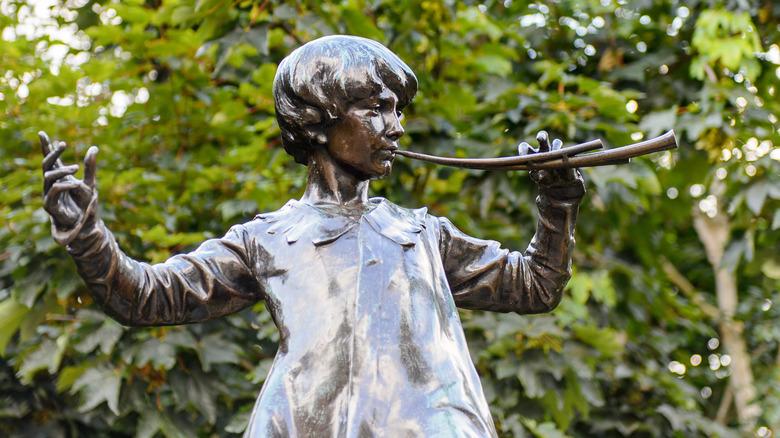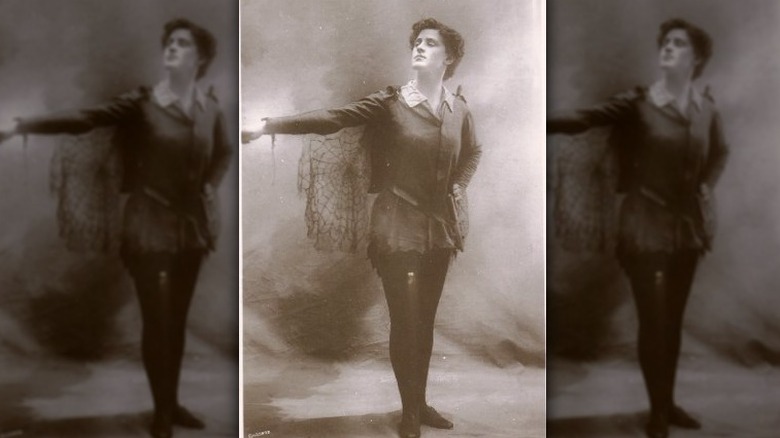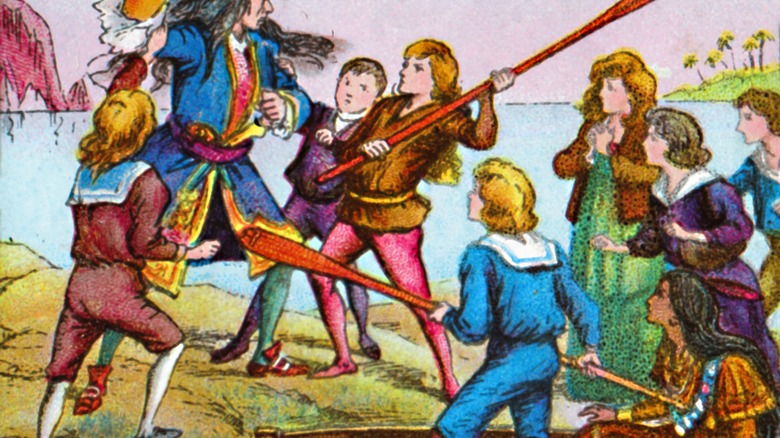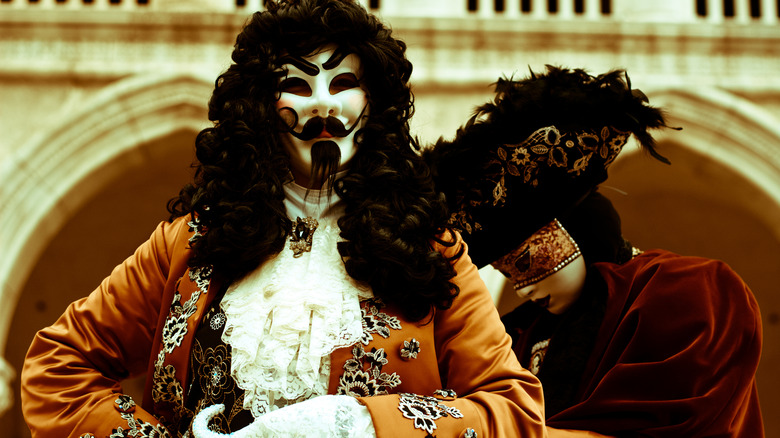The Dark Origin Story Of Peter Pan
Peter Pan is one of the most popular stories of all time, and it's also one of those stories that continues to see more and more adaptations, all of which with new bends and twists on the classic children's story — the story of a magical young boy who refuses to grow up and encourages other kids to do the same. All while banding together, fighting pirates, and maybe or maybe not finding loving mothers.
But the story as it exists today, after the likes of Disney's animated "Peter Pan" and "Hook," doesn't carry all the dark, sinister threads that author J.M. Barrie originally wrote in the very first version of it — his book titled "Peter and Wendy."
As with most fairy tales, a la the Brothers Grimm, "Peter Pan" has a dark underbelly — not just in the nature of the story itself but in the themes and motifs that come from it. There are just a lot of dark undertones surrounding "Peter Pan," both as a story and as an anchor of J.M. Barrie's own dark past.
Here's a look at that origin story.
Peter Pan first appeared in a different J.M. Barrie novel
The character of Peter Pan himself originated in another J.M. Barrie novel — "The Little White Bird." The rather tragic tale, meant for an adult audience, only involved Peter for a small section, where an infant Peter flies out of his window to play with fairies and returns to find the window barred, his mother cuddling another child, according to Vox. That's tragic enough as is, but it turns out the story's central character is a man wanting the little boy for his own, making up the story of Peter to delight and entertain the child.
From this disturbing take, Barrie built an entire play, "Peter Pan, or The Boy Who Refused To Grow Up," and a novel, "Peter and Wendy," out of the sad story of the boy forgotten too soon by his mother.
Here we see so much of what makes Peter Pan who he is: the feelings of motherly abandonment, and the early independence but stunted growth. It's all there on display in this early origin of his sad life. And as Rosalind Ridley notes in her book, "Peter Pan and the Mind of J.M. Barrie," the undertones of this first novel are semi-autobiographical in nature, with Barrie as the father figure, characters representative of people in his life, and the theme of longing reflective of Barrie's own desire for a child.
The influence of J.M. Barrie's own childhood
There are a lot of themes that are easy to pull out of the pages of "Peter and Wendy," and the one that survives even the most modern and toned-down adaptation is the notion of perpetual childhood and refusing to grow up. After all, Peter himself is a child stuck as he is, always with the real-world disconnect that most children have. The influences and origins of this theme can be plucked right out of J.M Barrie's own tragic childhood, which is the original dark origin point of the entire universe of the story.
In the book, "Hide-and-Seek with Angels: A Life of J.M. Barrie," by Lisa Chaney, the parallels are plain to see. While he was born to parents who loved him and all of his 10 siblings, tragedy claimed the Barrie household early and often. Two of his siblings didn't live past infancy, and the hardest tragedy hit when his older brother, David Barrie — also his mother's favorite — died just two days shy of turning 14. This loss sent his mother into a depression that, in many ways, took J.M.'s own childhood away while also keeping him frozen in that moment of innocence.
Perhaps the most morbid influence to come out of these early days in the Barrie household was a thought conjured up by mother Barrie — that, since David died young, he therefore never had to grow up (via Owlcation).
The many faces of motherhood
Another of the major themes and origin points in "Peter and Wendy" is the nature of motherhood and the many different forms it can take, for better or worse, as per the Kean Quest Journal. Peter has an ongoing internal struggle over wanting a loving mother, while also not trusting mothers thanks to his own forgetting him so quickly. All of this can be seen in the origin of Peter in J.M. Barrie's first novel, "The Little White Bird." And to understand the origin of Peter Pan's disconnect with mothers, one can look at the influence in J.M.'s life.
J.M's relationship with his own mother, Margaret Ogilvy Barrie, had equal parts love and sadness, particularly after the loss of his brother, according to the New Yorker. While there were never any mentions of his mother not loving all the children, she definitely picked her favorite — David Barrie — and that had a lasting effect on J.M. That dual nature of want and distrust connects to a particular moment in Margaret's life, referenced in "Hide-and-Seek with Angels," by Lisa Chaney. Her mother died when she was 8, leaving her to take care of the household. As Chaney notes, whether his mother shared stories with young J.M., or he as the consummate storyteller took liberties, Margaret didn't have much of a childhood.
And yet, one of J.M's early titles for the play version of Peter Pan was "The Boy Who Hated Mothers," according to the Yale Edition, and he intended for Captain Hook to be played by the same actor who played Mrs. Darling.
The Llewelyn Davies boys were the Lost Boys
One of the most well-known influences of "Peter and Wendy" is the Llewelyn Davies family (via History Daily). J.M. Barrie found a friendship in their five young boys and their mother, and the children and family enjoyed his company — they even vacationed together.
Some of the most iconic characters of any adaptation of "Peter Pan" are the Lost Boys, Peter's gang of boys he stole away from their parents. These Lost Boys are based off the Llewelyn Davies boys, who lost both their parents at a very young age and were "stolen away" by Barrie, as per The Telegraph. There was even a bit of trickery in Barrie becoming their guardian, with him altering Sylvia Llewelyn Davies' final will to instruct that Barrie become their legal guardian.
While there is no reason to think that there was anything nefarious in his intentions of becoming their guardian, it was a little reminiscent of Peter Pan, who coaxes Lost Boys from their homes with promises but can never serve the role of mother for them. Although, because it must be said, Barrie did provide a loving home for the boys.
J.M. Barrie developed an alter ego comparable to Peter Pan
Very early on in his creative life, J.M. Barrie adopted an alias of sorts — M'Connarchie. This name was used to refer to Barrie's creative side, as per The American Psychological Association, the side that wrote the stories. It allowed him to find his muse, to be his characters, and to leave everything else behind. Perhaps his own version of burying his tragedy in fantasy.
The American Psychological Association has taken this all a step further and assigned it an actual diagnosis — a regressive alter ego. The alter ego being Barrie's own inability to grow up, which ties into a lot of aspects of his creative adult life. But it's also attached to his time with his mother, which is when the alter ego is supposed to have developed. Perhaps this is why the pirates in "Peter and Wendy" wish they could have a loving mother and be a child again. Because Barrie did too.
Barrie's psychological condition reflects his chosen friends — children — and his own refusal to grow up that is everything that Peter Pan stands for. Not to mention the fact that Barrie was believed to have been celibate and asexual, much like a child still, according to the Telegraph. And his feelings of marriage were summed up in his personal journal (via the New Yorker): "Greatest horror — dream I am married — wake up shrieking."
Peter is obsessed with death
Seeing as how J.M. Barrie was so affected by death throughout his life, it was inevitably going to play a big part in any writing he did. Which makes it another one of those dark origin points that came together to form the story of Peter Pan. He lost loved ones and shared that loss with others, and that deep connection to death can be seen throughout the play and the novel.
Peter Pan is often interpreted as being obsessed with youthfulness, but in truth, he's more than a little obsessed with death, according to AbeBooks. There are so many scenes where Barrie leans into the gruesomeness of it all — Wendy being shot with arrows, Michael almost falling to his death, Hook being eaten by a crocodile. And one of Peter's most famous lines — "To die would be an awfully big adventure" — only serves to further the darkness circulating around the obsession with death, and how much of this book is about it.
Interpretations of Peter vary among scholars
Naturally, there are numerous interpretations of what all of this actually means and what J.M. Barrie intended to say with the story. Along with the inherent themes of retaining childish tendencies and the complicated nature of motherhood, there is a lot more that can be dug up in a world where children do not grow up, and the problems that come along with.
One scholarly interpretation from Lester D. Friedman (via The Week) is that Hook represents death, and the Crocodile represents time — the two things that Peter Pan is constantly trying to avoid by refusing to grow up. It's easy to see these influences in Barrie's life as well, given his history of familial death and the knowledge that comes with it — that time is limited. Both of which are imparted into Peter Pan.
Allison Kavey has another interpretation, according to The Week, and a very interesting one at that. She says that Pan has actually been dead this entire time. Kavey writes, "There is the sense that Neverland is the place that sick children go in their minds. But some never get to come home."
Peter Pan is a literal villain
Speaking of things you just can't ignore from the original narrative — Peter Pan is a villain. J.M. Barrie himself referred to his iconic character as "a demon boy," according to the Yale Edition, who also tell how the earliest adaptations of the play had Peter clearly stated as the villain. Just take a look at some of the things he does and talks about in the story. He captures children from their beds and steals them away. He openly admits to being in battles alongside the Lost Boys and randomly turning on them if he gets bored, oftentimes killing them, notes Vox.
Along with that, he has childish concepts of real love or friendship (via the Week). He has no real emotional connection to anyone, is selfish, and doesn't understand empathy. This is largely lost in modern adaptations that paint Peter as this heroic, noble character who seeks to avoid growing up because he believes in the purity of a child. Sure, there's a dose of that in the original work by Barrie, but there's also the accompanying negative side affects of a childish mind faced with real responsibilities.
The British Imperialism factor
At the time of creating "Peter Pan," the British imperialism was in full swing. Which meant that British holdings around the world sent reports home of the North American, Caribbean, and Asian Indigenous people that they encountered. Unfortunately, the less than savory depictions were adapted by J.M. Barrie in his writing of Tiger Lily and the her tribe. Tiger Lily's speech patterns — "Peter Pan save me. Me has velly nice friend" — are more than a little problematic, and the name of the tribe itself comes from colonizing Europeans who used it to apply to Black and Aboriginal children, according to Encyclopedia.com.
And not even Disney could make Tiger Lily look any better. They gave her no lines whatsoever.
The Piccaninny tribe are an obvious amalgam of all the conquered Indigenous peoples that the British treated so horribly throughout the colonial era, and while Barrie doesn't outright vilify them, as many other writers did at the time, the depiction is not exactly a great one and evokes familiar tropes.
The complexities of Captain Hook
To understand the dark origins of the story, one must look at the origins of other characters, namely the other unconventional villain, Captain Hook. The origin point of Hook comes from J.M. Barrie himself playacting as a "Captain Swarthy" with the Llewelyn Davies boys, according to the Telegraph. And the character stuck with Barrie from there.
The Week points out that when Barrie wrote the play "Peter Pan, or the Boy Who Wouldn't Grow Up," he included some new characters that hadn't yet been seen in "The Little White Bird" — namely Wendy, Tinkerbell, and Captain Hook. But Peter was still the villain until Barrie recognized the need for scene changes and, to accommodate, created Captain Hook. But Barrie's origin point of Hook develops from there. He gave an entire speech, according to the Atlantic, where he digs into the history of Hook and his collegiate years at Eton. Hook was an actual Eton alum and formal naval captain still living near the college in his waning years, often seen on campus, reviled as a sad figure "gazing with peeled eyes through the darkness of his present to the innocence of his past, from the monster he had become on the Spanish Main, to the person he had been at Eton."
But the real kicker comes from Barrie's casting of Hook, who was to be played by the same actor who played Mrs. Darling, the mother that Pan tries to get Wendy and her siblings to hate. But the character ends up being played by Mr. Darling, who is not-so-stealthily the father of the Llewelyn Davies boys in real life. It's now traditional for the actor who plays Mr. Darling to also play Hook — the man who imprisons the Lost Boys. Even in the Disney cartoon, they are both voiced by Hans Conried.
